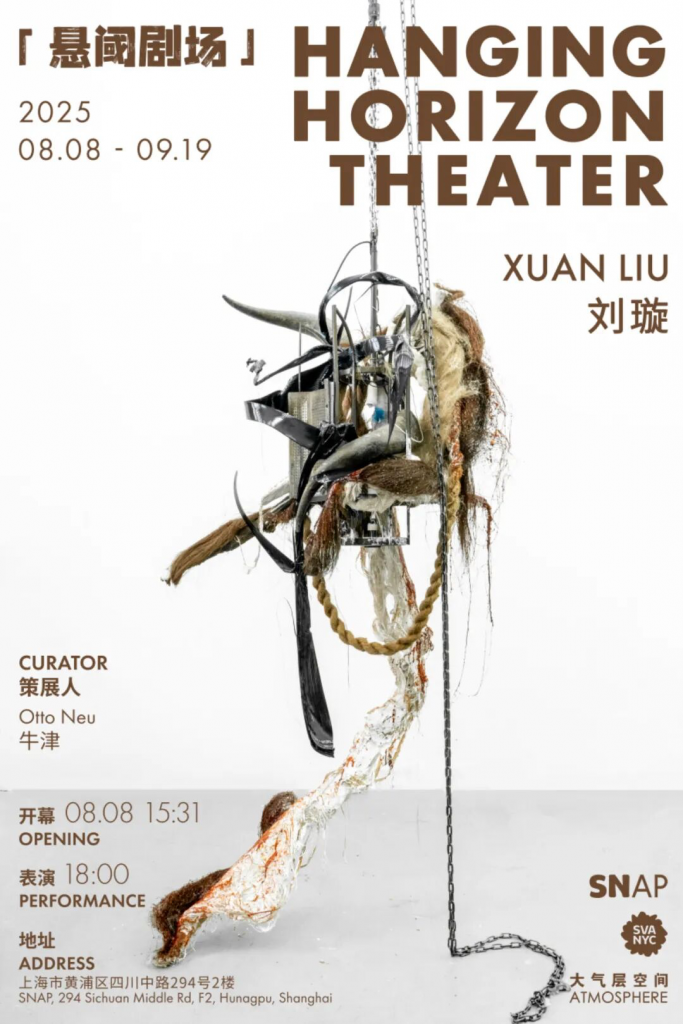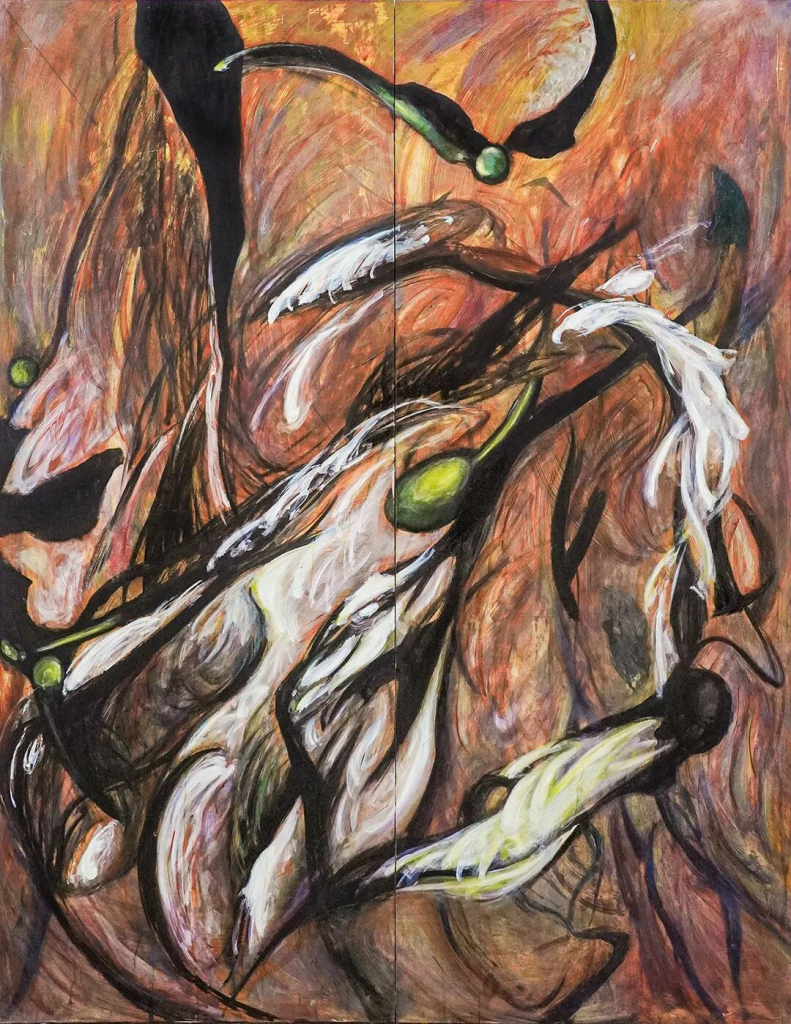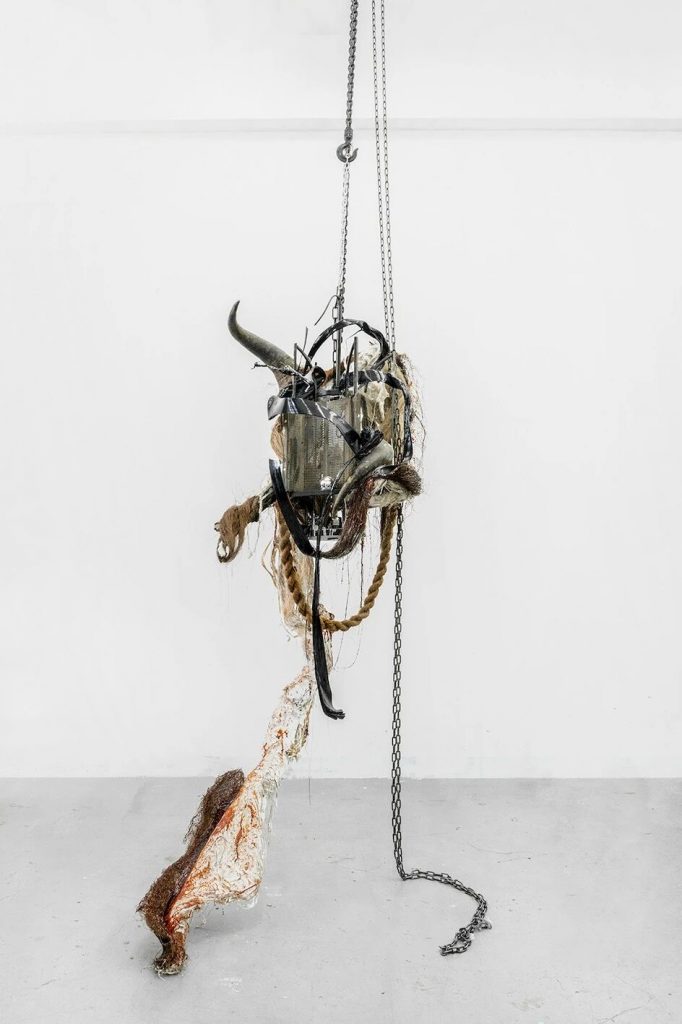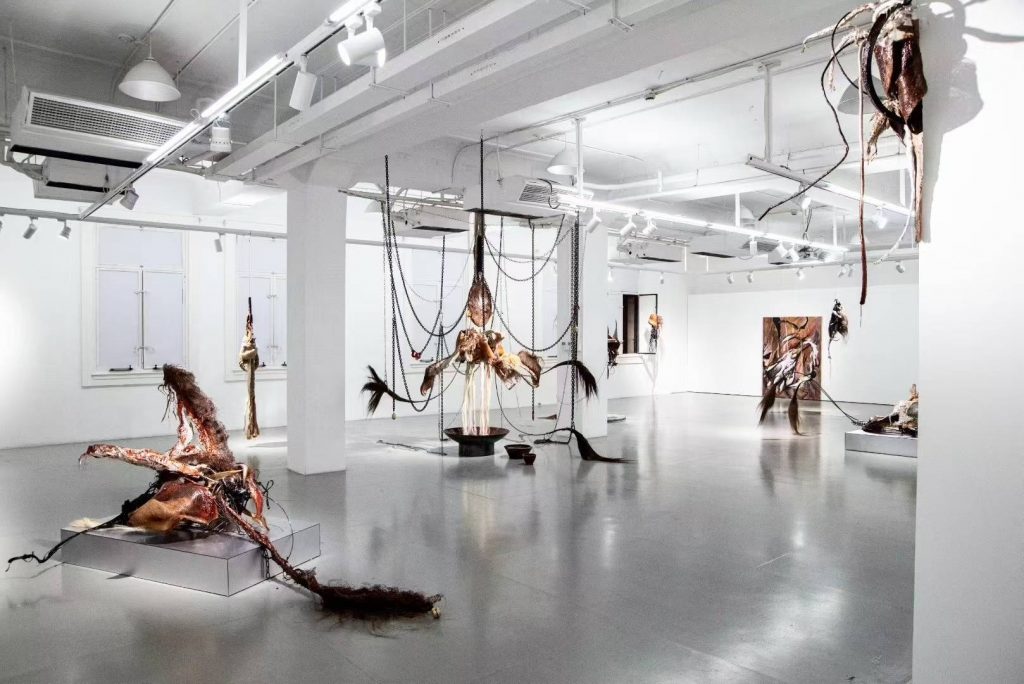
Hanging Horizon Theatre
策展人|CURATOR
牛津 Otto Neu
艺术家|ARTIST
刘璇 Liu Xuan
开幕时间|OPENING
2025.08.08 15:31
现场表演 Performance
18:00
展期|EXHIBITION DATES
2025.08.08 — 2025.09.19
地址|ADDRESS
SNAP艺术中心,上海市黄浦区四川中路294号2楼
294 Sichuan Middle Road, 2F, Huangpu, Shanghai
“我给你一根金线的末端,只要把它卷成一个球,
它就会引领你进入天门,天门就建在耶路撒冷城墙内。”
— 威廉·布莱克“我给你一根金线的末端,只要把它卷成一个球,
它就会引领你进入天门,天门就建在耶路撒冷城墙内。”
— 威廉·布莱克
刘璇是一位善于“转化”的艺术家,无论是生命赐予的痛苦、狂喜,或是刹那间如神启的灵感,她都毫无保留地将它们转化为视觉与听觉化的创作语言。这种“转化”也许来自于她那瘦小身体之中迸发出的旺盛生命力,而那股力量亦紧密连接着观众们的神经。刘璇的装置作品并非强调和谐的装饰主义,其粗犷、戏谑的呈现与不经意间发出的声音或许会让观者产生一种“轻微的不安感”,以此达成心理学中的“感觉阈限”(Threshold),即刚刚能引起感觉的刺激的最低值,将观者指向一种“介于已知与未知之间的临界状态”,亦为德勒兹 (Gilles Deleuze) 笔下的“感官机器”,在知觉尚未形成意识之际即被激活,以此将观众的感觉阈值无限放大在剧场式的展厅之中。
Liu Xuan (刘璇) is an artist of transformation. Whether drawn from pain, ecstasy, or sudden moments of divine inspiration, she unreservedly channels these visceral experiences into an expressive language of visuals and sound. This transformative instinct stems from a fierce vitality that bursts from her slight frame and forges an almost physical connection with her audience. Her installations are not ornamental or harmonious in any conventional sense; instead, their raw textures, playful absurdity, and accidental noises provoke an underlying unease. This evokes a psychological “sensory threshold” – the minimal stimulus capable of registering sensation – creating an experience: a liminal zone between the known and the unknown, akin to Deleuze’s “machines of sensation” that activate perception before consciousness forms. Within this theatrical space, perception is expanded and intensified.

摄影 Photo: Fin
对于刘璇而言,布莱克诗句中的“金线”通过材料与声音贯穿了她个展中的作品之间—— 她在这个“剧场”中缠绕着线的一头,在把绳子尾端交到观众手中之前,刘璇用她深刻、共情的创作语言编织出了那些由个体经验组成的装置与绘画作品。而绳线在人类历史中一直拥有着精妙且深刻的意象,其象征生命轨迹或神性的指引,亦曾是人类计时与纪事的工具,它带领我们走出迷途、牵引着我们先祖的踪迹。
For Liu, the “golden string” in Blake’s poem manifests through material and sound, weaving through each work in her solo exhibition. Before finally offering its other end to the audience within this “inner theatre”, she holds one end of the thread, using her profound and empathetic artistic language to weave its path through a landscape of installations and paintings shaped by personal experience. Moreover, throughout human history, the thread has embodied subtle yet profound symbolism. It serves as a metaphor for life’s trajectory or divine guidance, as well as a tool for measuring and recording. It is a map, a lineage, a lifeline.
.
当观者的目光经过开场作品《搅乳海#1》(Samudra Manthan#1) 时,便与刘璇手中那根无形的金线悄然系在了一起。作品中绳索、轮环与垂坠结构的缠绕,不仅具象呈现了“人”的复杂性,也延续了她长期探索的“人性三重性” (Human Triplicity) 理论:圆环象征神性,头部代表人性,而装置背后垂落的“尾巴”则隐喻着兽性——三者交缠于一体,共构出一个持续转化的存在体。这一结构亦同时呼应了作品标题所引用的印度神话“搅乳海” (Samudra Manthan) 的原型意象。神话中,众神与阿修罗为了获得不死甘露而合力搅动混沌之海,这一过程既是创造也是分裂:混沌与秩序、光明与黑暗、牺牲与欺骗并存其中。正如搅动之力催生宇宙秩序,刘璇也借此暗喻人性内部的机制——我们所谓的“人性”,其实源自神性、理性与本能的持续拉扯与协商,它们并非二元对立,而是如神魔交织般,处于一种不稳定的共生状态。她将这一神话原型转译为装置结构语言,并引导观者进入一场自我内部的“搅动”:刘璇并不试图用神话去讲述过去,而是借它激活观者此刻对“内在自我”的感知。那根交到观者手中的“金线”,既是连接艺术家与观众的媒介,也是引领他们进入自身内在剧场的路径。
As the viewer’s gaze falls upon the opening work, Samudra Manthan #1, it becomes quietly tethered to the invisible golden thread held by Liu Xuan. The intricate entanglement of ropes, rings, and pendant structures not only gives tangible form to the complexity of the human condition but also embodies her long-explored theory of “Human Triplicity”: the circular ring symbolises divinity, the head represents humanity, and the trailing “tail” gestures toward bestial instinct. These forces entwine to form a continuously shifting being.
This structure simultaneously resonates with the archetypal imagery of the Hindu myth, referenced in the title, of the Churning of the Ocean (Samudra Manthan), in which gods and demons jointly churn the chaotic sea to extract the nectar of immortality. This process is one of simultaneous creation and rupture, where chaos and order, light and darkness, sacrifice and deceit coexist and intertwine.
Just as the churning force births cosmic order, Liu employs the myth to allegorize the inner workings of human nature—what we call “humanity” arises from the ongoing tug-of-war and negotiation among divinity, rationality, and instinct.
These are not dichotomies but, like the entangled gods and demons, exist in a state of unstable symbiosis, perpetually locked in dynamic tension. She translates this mythological archetype into the language of installation structure, guiding viewers into an internal “churning” of their own.
For Liu, myth is not invoked to recount the past but to activate the viewer’s perception of their “inner self” in the present moment. Thus, the gold thread handed to viewers is both a conduit connecting the artist and the audience, and a path leading them into their own interior theater.

在这个剧场之中,刘璇的装置《超人即是大地》(Der Übermensch sei der Sinn der Erde) 亦回应着尼采的呼喊:“忠于大地吧!不要相信那些向你们述说超越大地希望的人”。她将超人的意象植根于脚下的土壤之中—— 装置的尾巴深深垂向地面,像是在向大地汲取能量,聆听着它的耳语。对刘璇而言,触碰大地,是一种回归自然秩序的亲密姿态,亦是源自信任与安全感的生命动作,更是对自身存有的一种复归。
Within this theater, Der Übermensch sei der Sinn der Erde (“The Superman is the meaning of the earth”) likewise responds directly to Nietzsche’s exhortation: “Be faithful to the earth, and do not believe those who speak to you of otherworldly hopes.”
Liu anchors the figure of the Übermensch not in transcendence but in the soil beneath our feet—the installation’s tail descends deeply into the ground, as though drawing sustenance from the earth, listening to its whispers. For Liu, to touch the earth is simultaneously: an intimate gesture of returning to the natural order; a life-affirming act rooted in trust and safety; and ultimately, a homecoming to one’s own being.

而互动装置作品《神在游戏》(Līlayati) 则悄然展露了潜藏在刘璇深刻、严肃的创作语言里的幽默感。当观者去拉下装置下方的拉环时,便赋予了这件作品生命与动态,它的主体将如水母般地轻快上下弹跳,装置的反弹力亦隐喻了人性的灵活与弹性。这件作品中包含着深刻的生命体会,并以一种戏谑与幽默的态度探讨着自由生命的虚无。如若无法获得那所谓的终极自由,那不如苦中作乐,以戏谑和调皮作为人生态度去面对一切。亦如尼采所云:“唯有当人与命运共舞,生命才具有美的力量”。在刘璇的作品中,戏谑不再是逃避的途径,而是在幽默中对抗虚无的生命姿态——一种不依赖痛苦叙事,而单纯靠生命力量去燃烧的存在方式。
Liu anchors the figure of the Übermensch not in transcendence but in the soil beneath our feet—the installation’s tail descends deeply into the ground, as though drawing sustenance from the earth, listening to its whispers. For Liu, to touch the earth is simultaneously: an intimate gesture of returning to the natural order; a life-affirming act rooted in trust and safety; and ultimately, a homecoming to one’s own being.
The interactive installation Līlayati (God at Play) unveils humor concealed within Liu Xuan’s predominantly rigorous artistic language. When the viewer pulls the ring beneath the work, it releases the mechanism, bringing the sculpture to life in undulating, jellyfish-like pulsations. This elastic rebound serves as a kinetic metaphor for human adaptability and resilience.
Embedded here is a profound meditation on existence: if absolute freedom proves unattainable, why not confront the void with deliberate levity—transforming existential weight into gallows humor? As Nietzsche declared: “Life attains its force of beauty only when one dances in step with fate.” In Liu’s lexicon, playfulness is neither evasion nor diversion, but a posture of resistance against nihilism—a declaration of vitality that ignites existence through sheer life-force, bypassing the crutch of suffering narratives, a new way to burn bright.

在人类社会化的进程中,种种制度与形式在建构秩序的同时,亦层层限制着人性中那原始、未经雕琢的“兽性”。文明的历史从不是一场单纯的进步叙事,而是权力、规训与控制机制悄然编织的网,让我们看见那些被驱逐、被压抑的生命能量——而这一股被驯化之力所驱逐的兽性,被艺术家放大并凝结成了展览中体量最庞大的装置之一——《露莎卡的声音》(Voice of Rusalka)。当观众被手中牵引的“金线”悄然将其引向此处,一具仿若昆虫的庞大结构正匍匐于地,几近隐匿。它并不喧哗,却充满张力——仿佛随时可能跳跃的潜能。装置前端的触角在被轻触时会发出清脆的铃响,既温柔又警觉。就如自然界中的昆虫般,触角是其感知世界、辨识危险、建立关系的器官,是界面亦是通道,象征着本能与感知力的复苏。
In the process of human socialization, the very institutions and forms that construct order simultaneously impose layer upon layer of constraint upon the primal, uncultivated “animality” within human nature. The history of civilization is never a simple narrative of progress, but rather a web subtly woven by power, discipline, and mechanisms of control—a web that lays bare those vital energies expelled and repressed.
And it is this very beastliness, expelled by the forces of domestication, that the artist amplifies and condenses into one of the exhibition’s largest installations, Voice of Rusalka. Guided by the golden thread, the audience encounters a giant insect-like form crouched low to the floor, nearly hidden. It is silent but charged with tension—poised with the latent potential to leap at any moment—its antennae, when lightly touched, emit a clear, bell-like chime, both gentle and alert.
Just as in the natural world, where antennae serve as organs for perceiving the world, discerning danger, and forging connections—acting as both interface and conduit—here they symbolize the reawakening of instinct and the resurgence of sensory perception.
这件作品的背后,是四张大尺幅的绘画《 ACT 1/2/3/4 》,它们以一种动态生成的语言不断自我演化,充满冒险精神与偶发性,每一笔都如同在不可预测的生命路径中生长的意识碎片。这组绘画扩展了艺术家对“人性三重性”复杂共生关系的持续探讨。装置《露莎卡的声音》正倒卧于这组绘画之间,不再作为独立的主体,而成为画面的一部分。兽性的倒下,并非消亡,而是一种暴露与接纳,是艺术家借此回应那被遮蔽的欲望、冲动与深层本我。在这层意义上,《露莎卡的声音》既是一尊坠落的困兽,也是一面反映我们自身原初面孔的镜子。
Behind this sculpture hangs a quartet of large paintings, ACT 1-4. These works employ a dynamic, generative language that perpetually self-evolves, embodying a spirit of adventure and serendipity. Each brushstroke resembles a fragment of consciousness taking root and growing along unpredictable life paths.
This group of paintings extends the artist’s ongoing investigation into the complex symbiotic relationships inherent in her theory of “Human Triplicity”. Voice of Rusalka lies collapsed between them, no longer an autonomous entity but dissolving into the painted surface as an integral part of the tableau. The fall of the beastly signifies not extinction, but a contemplative gaze and acceptance. Through this gesture, the artist responds to those obscured desires, impulses, and the deeper id. In this sense, Voice of Rusalka is simultaneously a fallen, cornered beast and a mirror reflecting our own original face.

摄影:温舒喻Photo: Wen Shuyu

随后呈现的两件作品《格莱普尼尔的六重门》(Six Gates of Gleipnir)与《藏匿的宝珠》 (Hidden Pearl) 共同回响着展览中贯穿始终的两个主题:自由与神性。它们皆以“门”为核心意象,但方向与路径却截然不同。在前者中,一座鸟笼般的结构向外扩张,似乎正在突破自身的囹圄。置于其前方的铁门构成了最后一道界限,象征着对禁忌的跨越与被规训自我的挣脱。这里的“门”不仅是通道,更是一次象征性的仪式——一个将个体从他律引向自我解放的过程。而《藏匿的宝珠》则是一次更为静谧的对照:它引领我们面对那道通向神性的门。人性的门往往由内而开,而神性的门,却需我们从外部去叩问。在这件作品中,前方垂落的铁线如珠链般悬挂,仿若古代中国仙像中的神性装饰,制造出一种神圣而不可直视的距离感。装置中隐匿的珠体暗示着“第三眼”的存在——神性的凝视,亦是一种超越理性的深层觉知。
Six Gates of Gleipnir and Hidden Pearl, resonate with the central dualities that permeate the exhibition: freedom and divinity. While both center on the motif of the “gate,” their orientations and pathways diverge fundamentally.
In the former one, a cage-like structure strains outward as if breaking free from its own confinement. An iron gate positioned before it marks the final boundary—a threshold symbolizing the transgression of taboos and the liberation from the disciplined self. Here, the gate is ritualistic—a passage not merely spatial, but existential, from external control to inner liberation.
The other work, in contrast, presents a far more tranquil counterpoint, guiding us to the gate leading to divinity. Where the gate of humanity often opens from within, the gate to divinity demands approach from without—an act of reverent seeking. Here, iron wires hanging like beaded strands evoke the sacred adornments found on ancient Chinese immortal statues, creating an aura of sacred distance, almost unbearable to behold directly. Hidden within, pearl-like beads suggest the presence of the “third eye”—symbolizing the divine gaze and a deeper, primal awareness that transcends rationality.

而在声音装置《贝努鸟》(Bennu) 中,刘璇则为观众创造了一种亲密而又疏离的互动体验,当观众轻推装置,它的弹力结构便回应以清脆跳跃的声响,隐喻着一种轻盈又执拗的生命节奏在空气中持续回弹。装置的律动感暗示了某种内在的循环——在一次次起落之间,我们被迫练习如何在生命中的无常中保持平衡。作品标题源自古埃及神话,贝努鸟为太阳神的灵魂,每日随光升起、入夜又与混沌交战,以确保次日曙光的重临。刘璇取其意象,却并不陈述神话,而是将其转译为一种存在状态:白昼与黑夜的来回,不再是时间的机械推进,而是某种必须练习的节奏。我们如何在命题反复中仍保留弹性?如何在一次次不确定与失衡中找到身体的中轴?在这件作品中,“平衡”不再是一种终点,而是与不稳定达成和解的方式。
In the sound installation Bennu, Liu Xuan crafts an experience for the viewer that is both intimate and estranged. When the viewer gently pushes the structure, its elastic components respond with crisp, leaping sounds that resonate through the air, metaphorizing a light yet stubborn life rhythm in perpetual rebound.
The rhythmic cadence of the installation hints at an inherent cycle—amidst these repeated ascents and descents, we are compelled to practice maintaining balance within life’s inherent flux. The title draws from ancient Egyptian mythology, where the Bennu bird, the soul of the sun god, rises with the dawn each day and battles the primordial chaos each night to ensure the return of the light.
Liu seizes this imagery, not to recount the myth, but to translate it into an existential cadence—day and night not as chronology, but practice. The questions then arise: How do we retain suppleness within the recurring cycles of existence? How do we locate our bodily axis amidst perpetual uncertainty and imbalance? In this work, “balance” is not an endpoint, but a mode of reconciliation with instability.
在最后,当我们审视刘璇的创作时,会发现对她而言物质从不只是材料,神话亦不只是故事。通过那根由材料及声音构成的“金线”,她编织出的那一组组令人“舒适地不安”的装置作品恰好成为一种能够唤起观众原始感知与深层共情的感官体验。当我们终于抵达她手中线团的终点时,我们所触碰到的将是柔软的生命经验与隐喻,更是我们自身内部那条始终未曾断裂的线索—金线时而紧绷,时而松弛,却总在提醒我们,如何与生命本身的荒诞与神圣持续协商。
Reflecting upon Liu Xuan’s work, matter transcends mere materiality, and myth exceeds simple narrative. Via this “golden thread” woven from material and sound, she crafts installations that are “comfortably unsettling”—experiences which precisely serve to awaken the viewer’s primal perception and evoke profound empathy through heightened sensory engagement.
When we finally reach the end of the skein, what we touch is the soft fabric of her lived experience—and, more crucially, that unbroken thread which runs deep within ourselves. This golden thread slackens and tightens, yet remains unbroken, perpetually reminding us how to engage in an ongoing negotiation with the inherent absurdity and sanctity of life itself.
刘璇并不试图通过这场展览回答什么,而是在这个“内在剧场”中一次次的晃动、响声、回弹之间,逼近一种可能的共识:我们终其一生所面对的,并非如何成为“完整的人”,而是如何与自己的未竟之事和平共处。那些隐匿于作品中的“尾巴”、“触角”、“门”与“铃音”,也许正是我们自我边界的延伸——它们向外探寻世界,亦回过头来抚摸我们的肉与灵。在这些交错的路径之间,刘璇以她幽默而敏锐的方式提醒着我们:真正的自由,不是摆脱一切,而是学会在被规训与欲望之间,持续地、轻快地摇摆
Liu Xuan seeks no definitive answers within this “inner theater.” Instead, through its oscillations, reverberations, and elastic returns, she approaches a collective epiphany: the human struggle lies not in achieving wholeness, but in reconciling with our essential incompleteness. The trailing tails, quivering antennae, liminal gates, and resonant chimes—become corporeal extensions of our own boundaries. They probe the external world while simultaneously folding inward to graze flesh and spirit alike.
At these interwoven roads, Liu delivers with darkly luminous wit: True freedom manifests not as liberation from constraint, but as the mastered art of perpetual oscillation—a buoyant, deliberate swaying between the poles of discipline and desire.
Written by OTTO